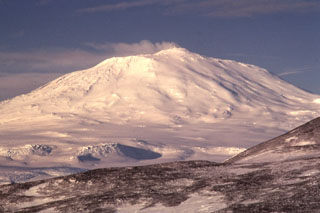Report on Erebus (Antarctica) — February 1989
Scientific Event Alert Network Bulletin, vol. 14, no. 2 (February 1989)
Managing Editor: Lindsay McClelland.
Erebus (Antarctica) Lava lake shrinks to three pools; Strombolian eruptions
Please cite this report as:
Global Volcanism Program, 1989. Report on Erebus (Antarctica) (McClelland, L., ed.). Scientific Event Alert Network Bulletin, 14:2. Smithsonian Institution. https://doi.org/10.5479/si.GVP.SEAN198902-390020
Erebus
Antarctica
77.53°S, 167.17°E; summit elev. 3794 m
All times are local (unless otherwise noted)
Geologists from Victoria University and the New Mexico Institute of Mining and Technology visited the summit of Mt. Erebus during December 1988. The following is from Philip Kyle. "Activity was generally low compared to previous years. Anorthoclase phonolite magma, still present in the summit's Inner Crater, was confined to three small pools (to 10 m in diameter). The pools were within a larger congealed lava lake that once exceeded about 25 m in diameter. Small Strombolian eruptions were rare, averaging <4/week. Several observed eruptions from the largest lava pool ejected a small number of bombs onto the Main Crater floor. Collapse of the southern Inner Crater wall continued to enlarge the crater slowly. SO2 emissions were ~30 t/d as measured by COSPEC. A video camera, permanently mounted on the crater rim, is being used to monitor and record eruptions."
Geological Summary. Mount Erebus, the world's southernmost historically active volcano, overlooks the McMurdo research station on Ross Island. It is the largest of three major volcanoes forming the crudely triangular Ross Island. The summit of the dominantly phonolitic volcano has been modified by one or two generations of caldera formation. A summit plateau at about 3,200 m elevation marks the rim of the youngest caldera, which formed during the late-Pleistocene and within which the modern cone was constructed. An elliptical 500 x 600 m wide, 110-m-deep crater truncates the summit and contains an active lava lake within a 250-m-wide, 100-m-deep inner crater; other lava lakes are sometimes present. The glacier-covered volcano was erupting when first sighted by Captain James Ross in 1841. Continuous lava-lake activity with minor explosions, punctuated by occasional larger Strombolian explosions that eject bombs onto the crater rim, has been documented since 1972, but has probably been occurring for much of the volcano's recent history.
Information Contacts: P. Kyle, New Mexico Institute of Mining and Technology; R. Dibble, Victoria Univ.

